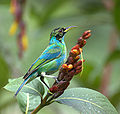- Green Honeycreeper
-
Green Honeycreeper 
Adult male Conservation status Scientific classification Kingdom: Animalia Phylum: Chordata Class: Aves Order: Passeriformes Family: Thraupidae Genus: Chlorophanes
Reichenbach, 1853Species: C. spiza Binomial name Chlorophanes spiza
(Linnaeus, 1766)The Green Honeycreeper, Chlorophanes spiza, is a small bird in the tanager family. It is found in the tropical New World from southern Mexico south to Brazil, and on Trinidad. It the only member of the genus Chlorophanes. The Purplish Honeycreeper (Chlorophanes purpurascens), a bird from Venezuela known only from the type specimen, is now thought to be an intergeneric hybrid between the Green Honeycreeper and either the Red-legged Honeycreeper or the Blue Dacnis.[1]
Contents
Description
The Green Honeycreeper is 13–14 cm (5-5.5 in) long and weighs 14 to 23 grams, averaging about 19 grams. It has a long decurved bill. The male is mainly blue-tinged green with a black head and a mostly bright yellow bill. The female Green Honeycreeper is grass-green, paler on the throat, and lacks the male's iridescence and black head. Immatures are plumaged similar to females. The call is a sharp chip.
Behaviour
This is a forest canopy species. The female Green Honeycreeper builds a small cup nest in a tree, and incubates the clutch of two brown-blotched white eggs for 13 days. It is less heavily dependent on nectar than the other honeycreepers, fruit being its main food (60%), with nectar (20%) and insects (15%) as less important components of its diet.
Gallery
References
- ^ Storer, Robert W. (1957). "The Hybrid Origin of Chlorophanes purpurascens". Auk 74 (4): 507. http://elibrary.unm.edu/sora/Auk/v074n04/p0507-p0507.pdf.
- BirdLife International (2004). Chlorophanes spiza. 2006. IUCN Red List of Threatened Species. IUCN 2006. www.iucnredlist.org. Retrieved on 12 May 2006. Database entry includes justification for why this species is of least concern
- ffrench, Richard (1991). A Guide to the Birds of Trinidad and Tobago (2nd edition ed.). Comstock Publishing. ISBN 0-8014-9792-2.
- Hilty, Steven L (2003). Birds of Venezuela. London: Christopher Helm. ISBN 0-7136-6418-5.
External links
 Media related to Chlorophanes spiza at Wikimedia Commons
Media related to Chlorophanes spiza at Wikimedia Commons- Green Honeycreeper videos on the Internet Bird Collection
- Stamps (for Guyana, Suriname, Trinidad and Tobago) with RangeMap
- Green Honeycreeper photo gallery VIREO
- Photo-High Res; Article tsgcs.co.uk
Categories:- IUCN Red List least concern species
- Thraupidae
- Genera of birds
- Birds of Central America
- Birds of Mexico
- Native birds of Southern Mexico
- Birds of Belize
- Birds of Guatemala
- Birds of Honduras
- Birds of Nicaragua
- Birds of Costa Rica
- Birds of Panama
- Birds of South America
- Birds of the Guianas
- Birds of the Amazon Basin
- Birds of Marajó Island
- Birds of Brazil
- Birds of Venezuela
- Birds of Colombia
- Birds of Ecuador
- Birds of Peru
- Birds of Bolivia
- Birds of Guyana
- Birds of Suriname
- Birds of French Guiana
- Birds of Trinidad and Tobago
- Monotypic bird genera
Wikimedia Foundation. 2010.





